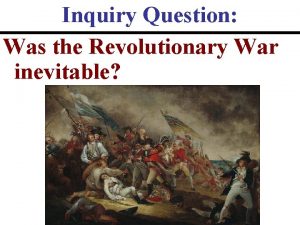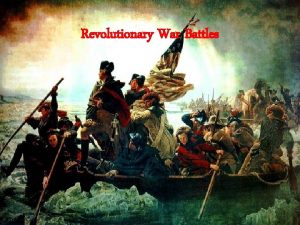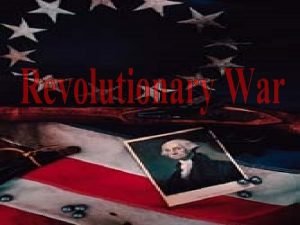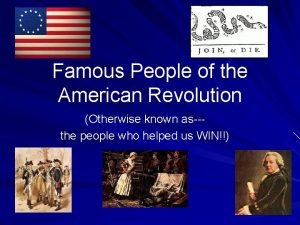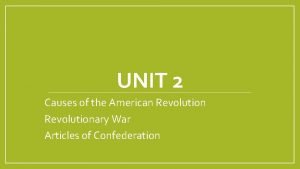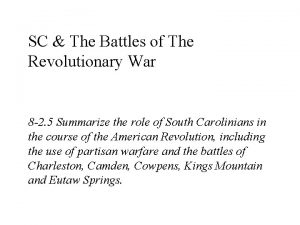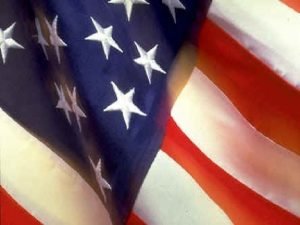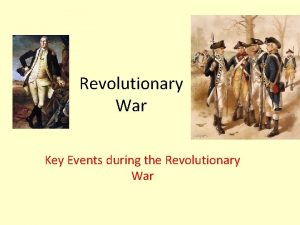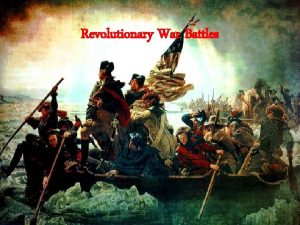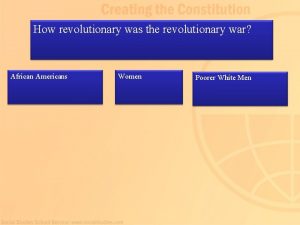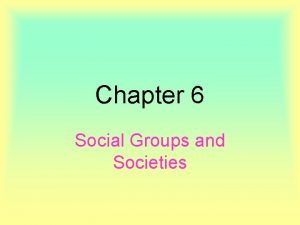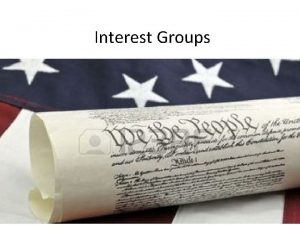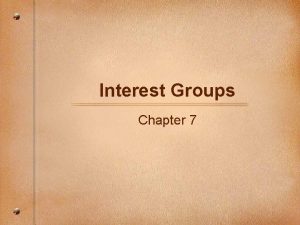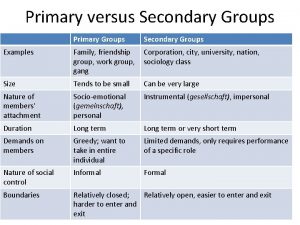How revolutionary was the Revolutionary War Groups 1

























- Slides: 25

How revolutionary was the Revolutionary War?

Groups 1. Women during the Revolutionary War- Chapter 5 2. African Americans during the war- Chapter 5 3. White Men After the War 4. Women After the War 5. African Americans After the War 6. Native Americans After the War 7. Changes in Government- Colonies to States

Questions to Answer 1. What was the role of your group during the war? 2. How did the war affect their daily lives? 3. TO WHAT EXTENT did the war affect their lives overall? YOU HAVE 15 MINUTES

White Women in Wartime During the Revolution, the assumptions about women barely changed Women were dependent on fathers and husbands Had no public role to play

White Women in Wartime (cont. ) However, in the midst of war women took on added responsibilities served visibly in support of the fighting men Raised $$$ for the troops Some even served incognito The gains and rights they deserved for this and other social responsibilities would be up for discussion in the new republic Abigail Adams would led fight for change

Abigail Adams “I desire that you would Remember the Ladies. We are determined to foment a Rebellion and will not hold ourselves bound by any Laws in which we have nor voice, or Representation, ” 1776

A Revolution for Black Americans In 1776, blacks accounted for 20% of U. S. population Almost all of them were enslaved Majority in the South 5, 000 blacks served in the Continental Army The Declaration of Independence’s words about equality made the Whigs uneasy about slavery The Quakers had taken the lead in attacking slavery

A Revolution for Black Americans (cont. ) Between 1777 and 1810 All northern states instituted gradual emancipation No southern states outlawed bondage Several southern states did make the voluntary freeing of slaves easier By 1790, about 5% of VA and MD blacks had been freed

A Revolution for Black Americans (cont. ) Most free blacks remained poor laborers, domestics, or tenant farmers Some blacks and whites began to advocate the idea that freed slaves might be better off being returned to their homelands in Africa (Prince Hall) Most states granted freedmen certain civil rights Blacks continued to be treated as 2 nd class citizens

The Revolution and Social Change Egalitarianism Among White Males There was no significant redistribution of wealth in America during the Revolution The Declaration of Independence’s bold assertion that “all men are created equal” did promote more egalitarian attitudes The upper class found it prudent to simplify their standards of living and treat common people with more respect

Egalitarianism Among White Males (cont. ) Ordinary people were less likely to defer to their “betters” or automatically leave governing to them Wanted more representation in government even if they didn’t own property Americans began to feel that political leaders should some from the “natural aristocracy” Men who demonstrated virtue accomplishments dedication to the public good

Egalitarianism Among White Males (cont. ) The gains made through the advantage of family retreated before the republican principle of ability The new egalitarianism did not include women, blacks, Indians, and landless white men

Native Americans and the Revolution Native Americans suffered the worst of any group during the War For many whites the republic’s promise of equal opportunity meant moving west to obtain their own land Moving into Indian territory The tribes of the Ohio Valley were especially vulnerable Between 1754 and 1783, war and uprooting had reduced the Native American population east of the Mississippi by nearly 50%

Native Americans and the Revolution (cont. ) Many Indians still living east of the River adapted some features of white culture, combined it with native customs, and created new lifestyles But they insisted on their right to control their own communities and lives

Forging New Governments From Colonies to States Certain beliefs inherited from the colonial era stood in the way of a thorough democratization of politics Most Whigs believed that voting and office holding must be tied to property ownership They frowned on political parties as strife-causing factions They did not see the need for apportioning seats in a legislature on the basis of population

From Colonies to States (cont. ) Whigs were wary of unchecked executive authority Why? Inclined to increase the role of elected legislatures Interested in framing government institutions that would balance the interests of different classes to prevent any one group from gaining absolute power

From Colonies to States (cont. ) The 1 st state constitutions reflected both the radical and traditional features of Whig thought Except for PA’s, they did not provide for election districts that were equal in population 9 of the 13 state reduced property qualifications for voting But none abolished them entirely By 1784, all state constitutions included a bill of rights

From Colonies to States (cont. ) The state constitutions provided for frequent elections and stripped the governors of most of their powers In 1780’s, many states revised their constitutions to strengthen the executive branch and increase the political power of wealthy elites

From Colonies to States (cont. ) Most of the states also enacted social reforms For Example In VA, Thomas Jefferson framed legislation abolishing primogeniture (the right of the 1 st child to inherit their parents property) Abolishing entails (to restrict inheritance of property in a will) the established churches guaranteeing religious freedom

Formalizing a Confederation, 1776 -1781 In 1777, the Continental Congress drafted a constitution called the Articles of Confederation 4 years passed before the states ratified the Articles of Confederation Disputes over states’ claims to western land their representation in Congress

Formalizing a Confederation, 1776 -1781 (cont. ) There was a unicameral congress in which each state had 1 vote No national court system No executive branch Financial, diplomatic, and military affairs were managed by congressional committees The congress could request funds from states but could not tax the people directly or regulate interstate and foreign commerce

Formalizing a Confederation, 1776 -1781 (cont. ) The Articles affirmed the new nation’s attachment to decentralized power when it reserved to each state full “sovereignty, freedom, and independence” This left the national government severely limited in important respects

Finance, Trade, and the Economy, 1781 -1786 The confederation proved too weak to meet its greatest challenge (putting the country’s finances on a sound basis) Unable to tax the people or force the states to contribute funds the congress could not pay off it Revolutionary War debt Or meet its operating expenses

Finance, Trade, and the Economy, 1781 -1786 (cont. ) Nor could the government under the Articles win diplomatic concessions from the British, who badly hurt New England shippers and merchants by shutting them out of the West Indian trade and imposing steep customs fees on goods entering England

Writing Prompt Asses how revolutionary the Revolutionary War was for America. Include changes in land ownership, who held the power, social reforms.
 What were the british strengths and weaknesses
What were the british strengths and weaknesses Swampfox mohawk
Swampfox mohawk Was the revolutionary war inevitable
Was the revolutionary war inevitable Fort ticonderoga map
Fort ticonderoga map Revolutionary period literature
Revolutionary period literature American revolution interactive notebook
American revolution interactive notebook Boston tea party diorama ideas
Boston tea party diorama ideas Revolutionary
Revolutionary Revolutionary war abc book
Revolutionary war abc book King of england during revolutionary war
King of england during revolutionary war British strengths during the revolutionary war
British strengths during the revolutionary war Which battle
Which battle Revolutionary war choice board
Revolutionary war choice board American revolt
American revolt Causes of the american revolutionary war
Causes of the american revolutionary war Revolutionary war
Revolutionary war American revolution strengths and weaknesses
American revolution strengths and weaknesses Turning point of the revolutionary war
Turning point of the revolutionary war Revolutionary war blockade
Revolutionary war blockade American revolution jeopardy
American revolution jeopardy Music of the revolutionary war
Music of the revolutionary war How are ethnic groups and religious groups related
How are ethnic groups and religious groups related Chapter 30 the war to end war
Chapter 30 the war to end war The cold war begins lesson 1
The cold war begins lesson 1 Chapter 16 lesson 2 challenges to slavery
Chapter 16 lesson 2 challenges to slavery Balanced force
Balanced force


